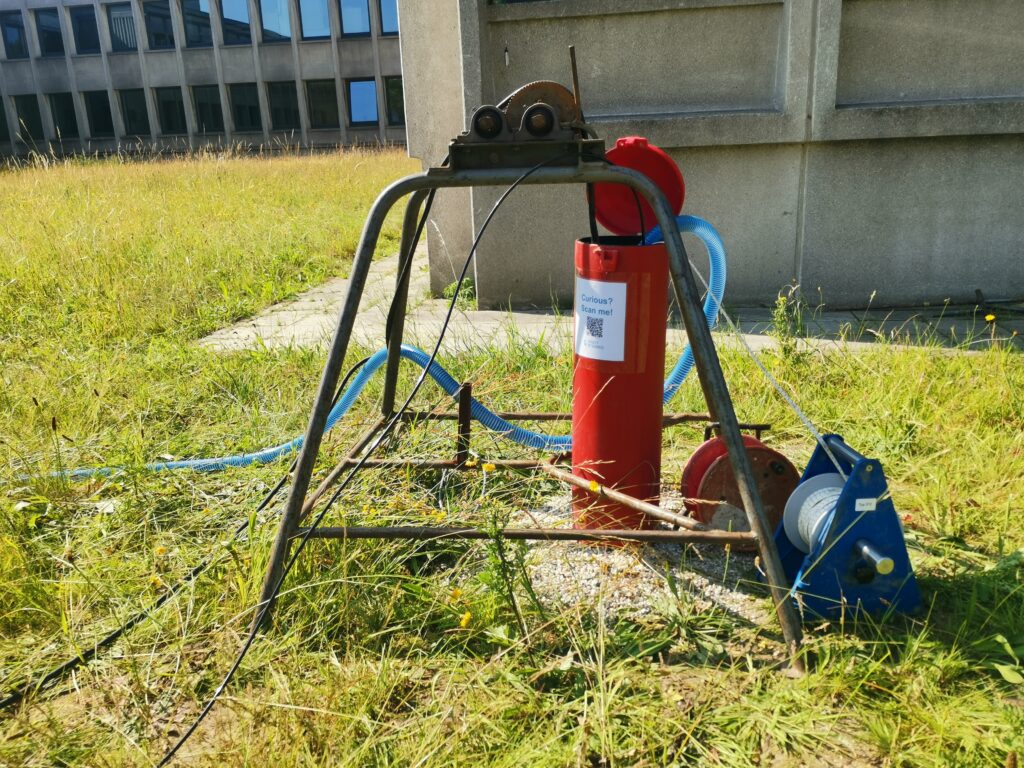What is this?

This is a groundwater well. Essentially, it is a pvc tube that extends 41 meters (campus Ardoyen) / 53 meters (campus Sterre) below the ground surface. That’s over 3 times the height of the building you see in front of you! Tiny slits in the tube allow for water to enter the well. This well targets a groundwater reservoir at a depth of about 20 to 40 meters (campus Ardoyen) / 10 to 53 meters (campus Sterre). You can imagine the reservoir as a volume of sand (and clay) with pore space in between the grains, which is filled with water.
A groundwater well can serve several purposes:
- monitor (natural) changes in groundwater level
- allow for pumping tests used to characterise the hydrogeological properties of the subsurface (for instance to determine how easily the water can flow)
- monitor groundwater quality
- …
Essentially, it can provide us with a glimpse of what is happening in the subsurface. This data can be used for various studies related to groundwater.
What is geothermal energy?
This particular well here on campus served to study the potential of a geothermal system. I am not talking about the kind of geothermal energy that uses the earth’s natural heat, like you find in Iceland. This kind of shallow geothermal system is actually a storage system. In summer, it stores the excess heat of buildings in the groundwater. In winter, this heat is recovered (pumped up) to heat the building, and cold water is stored for cooling in the next summer season.
These aquifer thermal energy storage (ATES) systems can therefore heat and cool buildings sustainably. One well pair can provide a high amount of energy, but this depends on the maximum extraction and injection flow rate the reservoir can sustain. ATES’s little sister is borehole thermal energy storage (BTES). Instead of using groundwater, a fluid circulates through tubes installed in the subsurface. It provides a lower amount of energy per well pair but is not limited by subsurface properties. If you have a geothermal system (ground-sourced heat pump) at home, chances are high that it’s a BTES system.

Here on campus, UGent policymakers are considering installing one of those two kinds of shallow geothermal systems. Our job consisted in exploring the subsurface possibilities.
What is a living lab?
A living lab is a collaboration between researchers, students, and policymakers. It allows for funding research relevant to Ghent University’s climate plan. The goal of a living lab is to reach a broader target audience, to encourage students to actively participate in research, to collaborate beyond disciplinary boundaries, and to make research outcomes applicable in real-life cases.
As part of this living lab, several pumping-injection tests were performed in the wells to accurately characterize the reservoir’s maximum capacity and to estimate key well and reservoir properties. These results serve to inform policymakers about the potential for implementing ATES on campus. Given the low capacity of the reservoir on campus, this study represents a true edge case for ATES applicability and provides a valuable comparison with BTES.
More fun facts about groundwater
- In Belgium, almost half of the drinking water produced is groundwater.
- Monitoring groundwater is a priority; there are over 70,000 measurement locations in Flanders.
- We cannot only store thermal energy (warm/cold water) in the subsurface, we can also store CO2.
- With geophysical methods, we can make an image of the composition and structure of the subsurface. We can also distinguish between fresh and salt water.
- Currently, there are almost 400 ATES systems active in Flanders. This makes Belgium one of the first countries to widely adapt shallow geothermal systems.
Want to know even more?
Check out the rest of our website: https://hydrogeo.ugent.be/team/
Get regular updates on our Facebook page: https://www.facebook.com/GeologieUGent
Contact luka.tas@ugent.be or thomas.hermans@ugent.be for more questions about the living lab
Other active living labs on campus: https://www.ugent.be/nl/univgent/missie